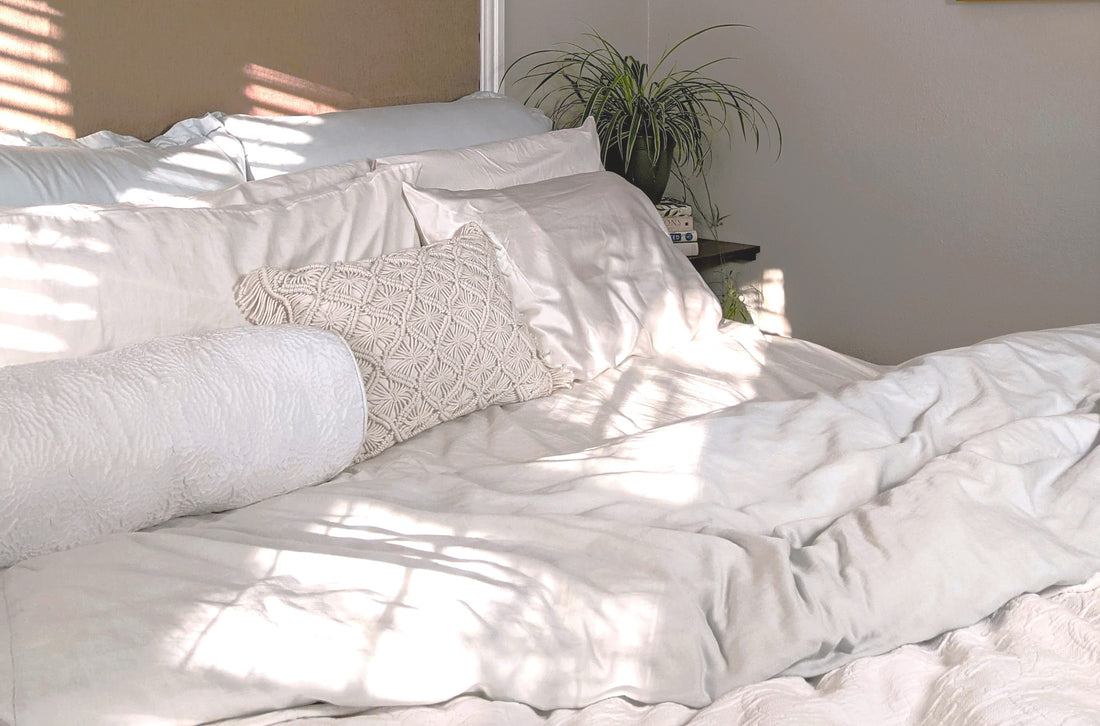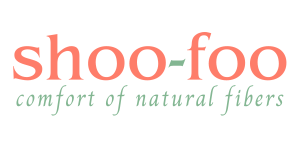
Eco-Friendly Bedding Choices: Sustainable Options
SHOO-FOO TeamShare
Have you noticed the growing trend of sustainable home building? More and more architects, builders, and homeowners are embracing eco-friendly practices to reduce the environmental impact of construction, save energy, and create healthier living spaces. But have you ever considered the impact your bedding has on both the planet and your well-being?
Just as the materials used in building your home are crucial, so too are the fabrics that surround you every night. The choices you make for your bedding can significantly affect your comfort and contribute to a healthier environment. In this blog, we'll delve into the various materials available for home linens, focusing on natural fibers and their numerous benefits. Plus, we’ll offer practical tips on selecting the right bedding to enhance your sleep while making a positive impact on the environment.
By the end of this read, you'll be well-equipped to choose bedding that not only wraps you in comfort but also helps make the world a better place—one sustainable fiber at a time.
Health Benefits of Eco-Friendly Bedding
Eco-friendly bedding is so important that it not only has a positive impact on the environment but also on your overall health and well-being. Made from sustainable materials, there are so many benefits that go beyond just a good night's sleep. Eco-friendly bedding helps minimize our environmental footprint while promoting better health by minimizing our contact with harmful chemicals! Additionally, eco-friendly bedding can provide durability and comfort, creating an incredible sleeping environment for you while having a positive impact on the environment.
What’s available: Materials and Fibers
Choosing natural materials and fibers for your bedding enhances your comfort, sustainability and style. However, each fiber tells a different story about its creation and ethical sourcing. From linen to bamboo, there are many options to choose from with their own unique benefits. When it comes to choosing eco-friendly bedding, the options can seem overwhelming, but don't worry - here we'll take a closer look at the exceptional qualities of hemp, kapok, linen and bamboo to help you find the perfect sustainable bedding solution for your needs.
Flax: crisp, cool and breathable.
One of the first natural fibers to explore is linen. Made from flax stalks woven into linen, the process is beneficial to the environment. Flax fibers are a natural and renewable source that generates less waste since every part of the plant is used. This fiber is thicker and longer than cotton while requiring significantly less water for its production! This fiber is known for its durability and breathability and has been used for years to create comfortable, long-lasting bedding.
Indeed, flax linen has a long history in the fashion world, from basic garments made by ancient civilizations to the durable and luxurious fiber that has been rediscovered more recently. Not only does this fiber has a long history, but it also stands out for its unique texture. Linen fabric is known for being crisp, cool and breathable. Linen bedding provides a timeless, comfortable and luxurious sleeping experience.
Hemp: comfortable, durable and sustainable.
Hemp is an excellent eco-friendly choice, both durable and sustainable. This fiber is harvested from the stem of the hemp plant and one plant can be harvested three times a year! Hemp plants need less maintenance and labor than many other crops, making them a great choice that is comfortable on the farmers hands and the planet. Hemp fiber is very durable. Hemp fabric can be used often and undergoes frequent washing without losing its shape which makes it a very good choice for clothing and also for bedding.
Hemp also has a high moisture absorption, odor control and natural antimicrobial properties. That makes hemp bedding a great choice for people who share their life with a pet. It is also great for absorbing moisture caused by potential accidents. Not only is it comfortable for you and your pets, but it is also environmentally friendly and a comfortable choice for bedding.
Kapok: lightweight, fluffy and vegan stuffing.
Unlike other materials, kapok is ethically sourced from the seed pods of the kapok tree, allowing the tree to continue to thrive without causing damage. This eco-friendly fiber requires little processing, leaving a lighter environmental footprint compared to other conventional bedding materials. Kapok is commonly used for insulation and stuffing in bedding products such as blankets, pillows, mattress toppers, etc. This fiber is known for its lightness which creates a sleeping environment that feels like floating on a fluffy cloud. This is perfect for people who appreciate softer, more cushioned bedding. Made with care and consideration for people and the planet, kapok bedding embodies the perfect blend of sustainability and comfort!
Bamboo: soft, antibacterial and breathable.
Known for its luxurious feel and sustainability, this fiber is not only gentle on the environment but gentle on the skin too. Harvested from the fast-growing bamboo plant, bamboo is celebrated for its ability to grow quickly without the need for replanting, artificial irrigation or fertilizers. This makes bamboo a sustainable and renewable source with minimal environmental impact.
Just like hemp, bamboo is known for is its natural antibacterial properties. This keeps your bedding fresher for longer in between washes! Plus, its exceptional moisture-wicking abilities keep you cool and dry all night long, making it the perfect choice for hot sleepers. Bamboo bedding is known for its silky smoothness and offers a gentle touch which is perfect for sleepers who appreciate comfort and gentle caresses against their skin.
Similarities and Environmental Impact
- Biodegradable: In addition to their individual benefits, all four of these eco-friendly bedding options share common characteristics for environmental sustainability. Hemp, kapok, flax, and bamboo are all biodegradable materials, meaning they naturally break down over time, minimizing their impact on the environment.
- Water savvy: Furthermore, they need significantly less water during the production and harvesting processes compared to conventional bedding materials, which is great for water conservation. By choosing one of these eco-friendly materials for your bedding, you are reducing strain on water resources and promoting water conservation.
-
No pesticides or fertilizers: All four materials are grown without the use of pesticides or synthetic fertilizers, further minimizing their environmental impact and ensuring a safer and healthier sleep environment without chemicals for you.
- Breathable and hypoallergenic: On top of these positive environmental impacts, these fibers also share common traits that directly influence your sleep experience and comfort. All of these beddings have great breathability and flax, hemp, and bamboo are all known for being moisture wicking, this can be great for hot sleepers. All four of these fibers share hypoallergenic properties which is great for sensitive skin sleepers. So, while all of these fibers share characteristics that are great for the environment, they also share many great characteristics that benefit you.
Tips for Choosing your Eco-Friendly Bedding
When choosing your eco-friendly bedding, there are many factors to think about to make sure you are making a choice that suits you. When reading about the different fibers you can see the unique properties that make each stand out, it is best to choose a bedding that aligns with your lifestyle.
If you are a pet owner, you might choose to go for one of the bedding choices that are more durable or have antimicrobial properties like hemp or bamboo. Adding onto this, while all four are hypoallergenic and safe for sensitive skin, you may choose a fabric like bamboo which is well-known for its incredibly soft and silky fabric. There are many factors to consider, but you definitely can find the perfect bedding that matches you. It can also help to do research on different brands and to read reviews to make sure you are supporting a brand that is focused on ethical sourcing and fair labour practices. Shoo Foo is a great example of a brand that is committed to eco sustainability and that offers bedding with all of the natural fibers explored above.
After exploring eco-friendly bedding options, it is clear that sustainability and comfort can go hand in hand. Whether you're drawn to the fluffiness of kapok, the silkiness of bamboo, the timeless elegance of linen, or the durability of hemp, each option offers a blend of sustainability and comfort. Buying materials that are eco-friendly and ethically sourced can create a sleep environment that not only promotes better health and well-being but also supports a healthier planet. With the many options of eco-friendly bedding to choose from, there's never been a better time to make the switch to sustainable sleep.
To help reduce harmful toxins in the environment and our homes, switching to bedding made of natural fibers is a start!

